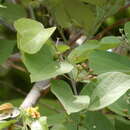Description
provided by eFloras
Trees 5-8 m tall. Branchlets gray stellate tomentose. Petiole ca. 1 cm, softly tomentose; leaf blade nearly orbicular or broadly ovate-orbicular, (1.7-)8-13(-36) × (1-)6.5-9.5(-24) cm, papery, black-brown when dry, with sparse solitary hairs or glabrescent and hairy only on veins adaxially, lateral basal veins 2/3 as long as leaf blade, 1.5-2.7 cm from margin, each with 5 or 6 secondary veins, dark brown, abaxially sparsely hairy or glabrous, base obliquely cordate, margin serrulate, apex shortly acute. Cymes 2-6 per leaf axil, 3-flowered; peduncle 1-1.5 cm. Pedicel 6-7 mm, gray-brown tomentose. Sepals oblong lanceolate, 7-8 mm, softly gray-yellow tomentose on both surfaces. Petals yellow, shorter and narrower than sepals. Stamens many, in 5 fascicles, slightly connate at base, slightly shorter than sepals. Ovary 2-loculed, hairy; style slightly longer than stamens. Drupe subglobose, not divided; exocarp not separating from endocarp; drupelets 1 or 2. Fl. Apr-Jun, fr. Jul-Aug.
- license
- cc-by-nc-sa-3.0
- copyright
- Missouri Botanical Garden, 4344 Shaw Boulevard, St. Louis, MO, 63110 USA
Distribution
provided by eFloras
Guangxi, SW Yunnan [Cambodia, India, Laos, Malaysia, Myanmar, Thailand, Vietnam; E Africa].
- license
- cc-by-nc-sa-3.0
- copyright
- Missouri Botanical Garden, 4344 Shaw Boulevard, St. Louis, MO, 63110 USA
Habitat
provided by eFloras
Open woodlands, shrublands, grasslands; 800-1600 m.
- license
- cc-by-nc-sa-3.0
- copyright
- Missouri Botanical Garden, 4344 Shaw Boulevard, St. Louis, MO, 63110 USA
Synonym
provided by eFloras
Grewia rotunda C. Y. Wu ex Hung T. Chang.
- license
- cc-by-nc-sa-3.0
- copyright
- Missouri Botanical Garden, 4344 Shaw Boulevard, St. Louis, MO, 63110 USA
Grewia tiliifolia: Brief Summary
provided by wikipedia EN
Grewia tiliifolia (syn. Grewia damine) is a species of flowering plant in the family Malvaceae sensu lato. A tree reaching 8 m (26 ft), it is found in monsoon and intermediate forest gaps and fringes of Sri Lanka, where the plant is known as "daminiya" in Sinhala and "chadachchi" in Tamil. It is also found in Pakistan (Sind, Punjab), India (Punjab, Madhya Pradesh, Peninsula), Nepal and Southeast Asia. Grewia tiliifolia is used in traditional medicine, using bark and roots for fractures, diarrhoea and skin diseases. Its wood is used for tool handles. The fruit is edible.
- license
- cc-by-sa-3.0
- copyright
- Wikipedia authors and editors

